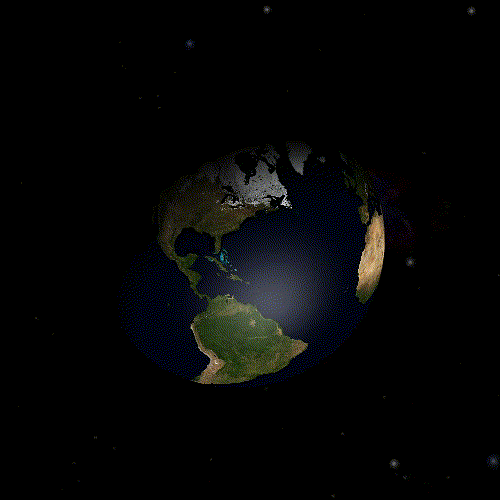Sometimes, stuff in space rotates[citation needed]. In this article, I am going to explain the basic idea to simulate rotation efficiently, and a few technical hurdles I encountered while implementing it.
I have not yet got down to reinventing the wheel writing a physics engine. Besides, I don’t want to simulate physics just to keep track of the orientation of the object through time. Doing so would drastically limit how much we can time-wrap (to maybe ×10,000).
Instead, we can just assume a constant rotation (angular velocity), and deduce the orientation at any given time from the base orientation and the elapsed time. In other words, we set:
Orientation(t) = Orientation(t₀) + AngularVelocity × (t – t₀).
This approach fits very well with planets, whose angular velocity can be safely assumed to be constant.
To handle simple changes in angular velocity, we can just update t₀. So, when the ship thrusts its RCS to pivot, we set t₀ to the current time, Orientation(t₀) to the current orientation, and update the angular velocity.
One thing remains: how do we represent an orientation or an angular velocity? There are essentially three ways:
- Euler angles
- axis-angle
- rotation matrix
- quaternion
Let’s go over each in more detail.
Euler angles use three angles around fixed axes. They are somewhat intuitive, but are very inconvenient to work with.
You can also find the rotation’s axis to get the axis-angle representation. You’ll need three values to describe the axis, and one for the angle.
Rotation matrices can be easily combined. They also adapt well to represent translation and scaling, when using homogeneous coordinates (convenient for 3D rendering). But they need at least 9 parameters.

The theory behind quaternions is hard to grasp, but you do not need to. What matters is that you can easily combine them, extrapolate them, or interpolate between two orientations, and they only use four values.
Actually, an intuitive way to think about them is that the first components x, y and z correspond to the axis of rotation, while the w component represents the angle of the rotation: if your angle of rotation is θ, then w=cos(θ/2). We just need to keep their norm to 1, so we scale x, y and z appropriately.
So, clearly, I use quaternions wherever I can. But there is one thing to keep in mind. Quaternions (almost) uniquely represent a rotation, and a rotation by angle x is the same as the rotation by angle 2π + x around the same axis. So, if we try to store an angular velocity of 2π rad/s (one rotation per second) as a quaternion, we’ll just have a quaternion representing an angular velocity of 0 rad/s (well, 0 rotation per second).
The usual way around this is to represent angular velocity (and impulse) as axis-angle, since we can store whatever we want in the angle. But I like edge cases and floating point Eldritch horrors. So, instead, I just scale the angle down by something like K=2¹⁰⁰. We will be fine as long as the angular velocity is smaller than 7.96×10³⁰ rad/s (26 billion billion (no typo) times faster than the fastest spinning object ever).
To summarize so far, we’ll use a quaternion to represent both the rotation and the angular velocity, except that we will scale the angle of the angular velocity by some gigantic value K.
It means we will create quaternions with very small angles.
It means that the component w will be extremely close to 1 (the distance will generally be about 1 / K = 2⁻¹⁰⁰).
It means that the component w will just be equal to 1 (since even double precision floating point numbers won’t have enough precision to tell the difference). We just lost all our precision!
It means that, when retrieving the angle from w (needed when scaling by t – t₀), we will just get 0.
It means that we will multiply 0 by K.
And 0 multiplied by a finite value (even very large) is still zero.
So nothing will ever spin. Great… back to Euler angles I guess?
Not so fast! Although we cannot retrieve small angles from the w component, the information is actually present in the other ones, x, y and z!
But you just told us that the x, y and z components are just the axis of rotation! Did you lie to us? Must my dreams always come crashing done at the altar of floating point numbers. I knew I should have gone with Cthulhu.
A sensible person when confronted with floating point arithmetic
It is true! But an axis is just a direction. When these three value also store a magnitude. Remember when I told you that we had to scale x, y and z so that the norm of the quaternion stays equal to 1? Well, that’s convenient, because it means that √(x² + y² + z²) = sin(θ/2).
And sin(θ/2) is very precise around zero in floating point arithmetic!
Which means we don’t lose any precision!
After checking with Herbie and opening a merge request in GLM (the library I use for manipulating quaternions), I am able to represent angular velocity as quaternions!

Could I just have used the axis-angle representation for angular velocity? Probably? Would it have been fun? Probably not as much.


Leave a Reply